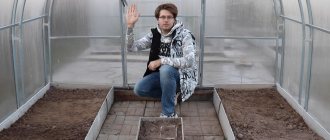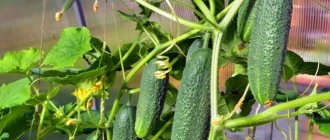Eggplants and cucumbers are fairly heat-loving crops, so they are not recommended to be planted in unprotected soil in the climatic conditions of the Moscow region and more northern regions. The highest yields can be achieved by growing crops in greenhouse conditions or greenhouses.
Beginning gardeners with a small plot of land often have the question of how to grow eggplants along with cucumbers in the same greenhouse, taking into account the compatibility factor of vegetable crops. The main difficulty of co-growing is due to different microclimate requirements. In this article you will find out whether it is possible to plant cucumbers and eggplants together.
Joint plantings
Neighborhood benefits
The main advantage of growing eggplants and cucumbers in the same greenhouse is that the vegetables do not have common diseases and pests. Consequently, the gardener can count on a good harvest. Also, both crops do not have a division into ordinary and those intended for growing in a greenhouse.
Are there any disadvantages
When growing cucumbers, drafts should not be allowed in the greenhouse, while eggplants are best grown in a ventilated room. The problem can be solved by using a polyethylene curtain, which limits draft access to the cucumbers.
Pest Control
Another problem that gardeners face when planting cucumbers and eggplants together is diseases and pests. These plants are very fond of aphids and spider mites. Diseases to which cucumbers are susceptible spread quickly, attacking neighboring crops.
- Check the leaves regularly. If diseases or pests are detected, treat with special solutions;
- To combat spider mites, treat plants 3-5 times so that the pest cannot restore the population. Among the chemical agents, acaricides have proven themselves to be effective; among the available ones, an infusion of potato tops;
- Natural remedies help get rid of aphids: onion peels, wood ash mixed with laundry soap. Both cucumbers and eggplants can be sprayed with such solutions;
- When gray rot appears, ventilate the greenhouse well and lubricate the affected areas of the plants with a special ointment.
Features of joint cultivation
It is almost impossible to create different temperatures or humidity in one greenhouse. Eggplants love sunlight, constant heat (+25-28 degrees), and prefer dry air. Cucumbers, on the contrary, love a humid climate with cool temperatures (+18-20 degrees). If the air in the greenhouse is too dry, the cucumber inflorescences will fall off.
In addition to temperature conditions, there are a number of requirements necessary for the growth of these crops:
- For eggplants to produce fruits, it is necessary to arrange one-sided ventilation of the greenhouse, providing access to fresh air. Drafts are strictly contraindicated for cucumbers, but ventilation does not harm them.
- The soil requirements for these crops are similar: it should be light, loose, and well fertilized. The same fertilizers are suitable for feeding; they must be applied at the same time. Cucumbers and eggplants should be watered at the root.
Some experts are categorically against the joint cultivation of these crops. Despite all the difficulties, judging by the reviews of experienced gardeners, cucumbers and eggplants planted together feel good. It is only necessary to meet several conditions to ensure the proper growth of different crops.
Advice. To grow cucumbers and eggplants together, you need a high greenhouse with good access to sunlight.
Eggplant is a self-pollinating crop, so cucumbers must be chosen in the same way.
Soil for seedlings
When planting and caring for seedlings, you need to choose the right soil and auxiliary fertilizers. This will help the seedlings to germinate faster and get stronger. For peppers and eggplants, a different soil mixture is used, so it is recommended to germinate the crops in separate containers.
For the blue ones:
- humus – 2 parts + peat – 1 part + rotted sawdust – ½ part;
- soil from the garden – 1 bucket + wood ash – ½ cup + superphosphate – 1 tbsp. + urea or potassium sulfate – 1 tsp.
For peppers:
- turf soil – 1 part + humus – 2 parts;
- peat – 2 parts + humus – 2 parts;
- turf soil – 3 parts + humus – 3 parts;
- peat soil – 2 parts + turf soil – 1 part;
- peat – 4 parts + turf soil – 2 parts + humus – 1 part + rotted sawdust – 1 part.
Gardeners do not recommend pre-sifting soil components through a sieve with a fine mesh. Otherwise, the substrate will turn out to be too soft, and after watering it will crust over. It is strictly unacceptable to place seed material in clean humus or compost. In undiluted form, these fertilizers only allow you to increase the green mass. The root system remains weak.
Do joint plantings affect pollination and fruiting?
Growing vegetables together does not reduce harvest volume or affect pollination. On the contrary, eggplants provide activation and support for the growth of cucumbers. It should be taken into account that eggplant is a self-pollinating plant, so the variety of cucumbers must be selected the same.
Growing different crops does not reduce yields, nor does it have any effect on the pollination process. On the contrary, eggplants help activate and support the growth of cucumbers. In addition, it should be taken into account that eggplant is capable of self-pollination, so a cucumber variety should be selected that is similar.
What requirements are taken into account?
Gardeners have different points of view regarding whether it is justified or not to plant cucumbers and eggplants in the same greenhouse. Despite many studies, there is no consensus. The reason is that eggplants and cucumbers require slightly different conditions to ensure their development.
Light, loose. The soil contains a sufficient amount of nutrients
Like, and eggplants
Carry out after the soil temperature reaches + 25 C
At a temperature not lower than + 22 C
Draft is contraindicated. Moderate ventilation allowed
Abundant at the root. The soil should be moist, but not wet. In addition, in the greenhouse the crop is often sprayed
Nutrient fertilizers of natural origin
In addition to organic substances, potassium, phosphorus, and nitrogen are added. Cucumbers should not be overfed
In limited quantities
Carrots, cucumbers, legumes
Peas, sunflower, Chinese cabbage, lettuce, corn
Basil, cilantro, oregano. Solanaceae
Before planting vegetables, the soil in the greenhouse is cleared of plant debris. The second step is adding organic matter and digging the beds. Watering is carried out at least twice. Preliminary disinfection of the soil will help reduce the activity of pathogens and pests.
Is it possible to grow eggplants and cucumbers together in a greenhouse?
Owners of small home greenhouse buildings strive to use square meters of soil to the greatest advantage. The relevant question for them is how to grow eggplants in a greenhouse with cucumbers and tomatoes; is it possible to combine these vegetables in one garden bed?
Cucumbers and eggplants are compatible because they require the same amount:
- heat,
- Sveta,
- moisture,
- fertilizing
Moreover, cucumbers and blue cucumbers need the same set of nutrients, so you can feed the bushes of both crops with the same fertilizers. These vegetables are planted in the ground after the same predecessors.
Video: What should you plant EGGPLANTS next to in your garden bed/vegetable garden, greenhouse/?!
Salad from under the knife
Another version of eggplant salad with cucumbers, peppers and other vegetables is suitable for consumption during the harvest season. This dish is considered an excellent addition to charcoal-grilled meat, barbecue, and just an outdoor lunch. Preparation does not take much time and does not require special skills. Everything is quite simple and fast.
Required ingredients:
- A couple of fresh eggplants.
- A couple of fresh cucumbers.
- Bulb onions.
- A couple of pickled cucumbers (you can use pickles if you like them better).
- Lemon juice.
- Salt to taste.
- Vegetable oil.
- Adjika (to taste) or tomatoes.
Stages of preparing eggplants with cucumbers:
- The eggplants are thoroughly washed and cut into small cubes (the shape is chosen individually, at the discretion of the housewife). Place in a bowl and sprinkle with salt, then set aside for 20 minutes.
- The onion must be cut into half rings, add the juice of one lemon and a pinch of salt. In this state, the onions must be left to marinate.
- At this time, put a frying pan greased with vegetable oil on the fire. The eggplants are gradually placed in the frying pan; first, they must be squeezed out of excess juice. Vegetables are fried until golden brown and placed in a separate bowl.
- At this time, pickled and fresh cucumbers are crushed and mixed in a separate bowl. Pickled onions are added to them, and the juice in which they were pickled is also poured out. Add a little salt and adjika (the amount is adjusted to taste).
- Mix everything thoroughly and add eggplant at the last moment. All this is seasoned with vegetable oil and served.
This dish will perfectly diversify your everyday or holiday table. This appetizer allows you to experiment with the spiciness and spiciness of the dish; much depends on the quality and quantity of adjika or tomatoes; additional addition of garlic or herbs is allowed.
How to plant plants together correctly
Eggplants grow well in the following conditions:
- dry, warm air (temperature - approximately twenty-eight degrees);
- unhindered access of the sun's rays to the bushes;
- watering with warm water directly under the root;
- carrying out tying, pinching.
The optimal conditions for cucumbers are:
- humid air (temperature - about nineteen degrees);
- soil fertilization (at least 3 times during the growing season);
- watering with warm water that has settled;
- carrying out treatment against diseases and pests.
Planting dates
Eggplants are planted next to cucumbers from February 20 to February 25. Cucumber seedlings are usually planted in early spring. The minimum ground temperature is fifteen degrees, air temperature is eighteen degrees.
Planting eggplants next to peppers
Sometimes a conflict arises between two vegetables, which completely destroys the plants. Crops are planted nearby due to their similarity in care.
Eggplants and peppers are capricious, so they require special conditions for development. It is also worth considering the distance when landing.
Features of eggplant and pepper
Neighborhood in a greenhouse
The compatibility of these two crops is good, which is why they are planted together. The proximity, due to a similar growing season, is why vegetables are sown in greenhouses at the same time (usually in February). Seedlings of both crops need good lighting, for which additional lamps are used. Avoid heated lamps: they cause burns on the sprouts.
The soil must be moist so that the root system does not dry out. These crops have a negative attitude towards drafts. 2 weeks after planting the seeds, the soil is fed with nitrogen-containing preparations. Vegetables need to be cared for regularly.
Neighborhood in the open ground
Eggplants are planted together with peppers in open areas, taking into account the distance that must be left between the beds. Plant only after a correctly calculated planting site: the root and ground systems will develop fully (distance - 60 cm).
Before planting, seedlings are hardened off. Initially, they are taken outside for 30 minutes, after which the time is gradually increased. The height of the sprouts must be at least 15 cm, and the shoot must have 10 full healthy leaves.
Caring for Eggplants and Peppers
In the garden, eggplant seedlings are watered at the root, and the same is done with peppers. Spraying has a negative effect on seedlings and causes infectious diseases. They are watered with warm water at a temperature of up to 22°C.
After watering, the soil is loosened (both in the greenhouse and in open ground). Loosening is carried out to a depth of 3-5 cm, without touching the root system.
When growing eggplants, they are periodically tied up in the garden, as they have tall shoots. A trellis is used for this. Excess ovaries are removed, leaving 2-3 on one bush.
Video
DO NOT PLANT THIS NEAR CUCUMBERS ✖️
?? What Can Be Planted in One Greenhouse - COMPATIBILITY OF VEGETABLES in the Vegetable Garden
These plants should not be planted next to each other
What to plant next to Pepper ✔️ What NOT to plant with pepper ✖️
Try to plant these plants together!
Who will be happy with the cucumber? What can you plant next to cucumbers?
Growing eggplants and peppers
Rules for joint planting of vegetables
IN ONE GREENHOUSE TOMATOES, CUCUMBERS, PEPPERS, EGGPLANTS/CORRECT PLANTING POSITION, PLANTING SEEDLINGS
Is it possible to plant tomatoes and cucumbers in the same greenhouse?
Crop rotation: scheme for alternating crops in the garden #2
Is it possible to grow peppers and eggplants in the same greenhouse?
VLOG/Our Experiment/ HOW TO Plant tomatoes, cucumbers, eggplants, peppers on the BALCONY. Consumption and all the nuances
How many tomatoes, cucumbers, peppers and eggplants to plant in 2020 so that there is enough for a family of 6 people
These vegetables cannot live without each other, only next to each other! This is what such a neighborhood will bring
REMEMBER THIS CHEET SHEET WHEN TO PLANT SEEDLINGS IN THE OPEN GROUND AND GREENHOUSE!
Tomatoes and cucumbers in a greenhouse. Is it possible to grow them together?!!
Joint planting with cucumbers
How do you like the article?
Ivanova Tatyana
Ask a Question
Preparing and planting seeds
Before planting, the seeds are placed for a day in a weak solution of potassium permanganate. If the packaging with seed is marked “F1”, then preliminary water procedures are not carried out. Place up to three seeds in one container. If everyone has ascended, then the strongest are chosen. Weak ones are removed. The second step is that the seed material is “relocated” into temporary pots for 80 days. Further actions:
- Cucumber seedlings are transferred into closed ground along with a peat container in which they have been kept for the last 70-80 days. It is allowed to move them immediately after at least two leaves appear.
- 5 days before planting eggplants next to future cucumbers, the greenhouse is heated. Seedlings will not tolerate temperature shock during transplantation.
Eggplants are planted in 2 lines. The distance between them is from 30 to 40 cm. It is necessary to increase the distance between the rows when tall eggplants are selected. The best option is to plant seedlings in a checkerboard pattern. Arrangement in one line is allowed if the summer resident bought spreading varieties.
Alternation of crops
Crop rotation, or alternation of crops, is a necessary measure to maintain soil fertility, reduce the number of weeds on the site, and prevent the accumulation of foci of diseases and parasites.
The crop turnover is usually 2-3 years.
Successful predecessors
Peppers will grow healthier and produce a larger harvest in the beds where they previously grew:
- zucchini;
- cucumbers;
- carrot;
- onion.
This is due to the fact that the organic matter added to the listed crops has time to rot well. The soil becomes loose and contains the optimal amount of nutrients for the pepper.
After which peppers are not planted
After tomatoes, eggplants, potatoes and other plants belonging to the nightshade family, pepper grows reluctantly.
The explanation for this is simple: all these crops take the same nutrition from the soil and are susceptible to the same diseases and pests.
What does compatibility depend on?
There is a slight difference in caring for both vegetables: the first requires watering at the root, and the second sometimes just needs to be sprayed. A high percentage of humidity is dangerous for eggplants, but on the contrary, it is beneficial for their neighbors.
Note!
The compatibility of crops depends on many natural, agroclimatic, and anthropogenic factors. But to a greater extent, everything is determined by the properties of each individual vegetable planted.
It is known that some types of crops can suppress the growth and development of others, so it is worth immediately foreseeing this scenario so as not to cause competition for space in the garden. Therefore, it is worth planting those plants that get along well, regardless of what kind of place it is - a greenhouse, a greenhouse or an open garden bed.
The benefits of mixed beds
To summarize all that has been said, I would like to note that planning mixed beds greatly helps save space and significantly improves the quality of the harvest. Soil resources are used more evenly, and the plants themselves serve as natural protection for each other from diseases and pests.
It should be taken into account that the planting scheme can be changed to suit the needs of your garden; we have given only general templates. But be sure to observe the compatibility of vegetables. This simple rule always gives excellent results and does not require any additional costs or investments.
Experienced gardeners harvest 11-15 kg of a wide variety of vegetables from one bed. The correct arrangement of plants in the garden also helps to save resources, as less water and fertilizers are required.
That, perhaps, is all about what the compatibility of vegetables in the beds is. For a list of plants that are “friends” and “not friends” with each other, see the table. Use it - and you are guaranteed a good harvest!
The practical side of the issue
Owners of small and spacious greenhouses solve the problem. The space is used rationally, but at the same time, the planting of cucumbers and eggplants is carried out in such a way that they are comfortable. Botanists give a clear answer. Both cultures are compatible when it comes to 4 parameters:
- warm;
- moisture;
- light;
- feeding
The difference is noticeable in watering. Partial compatibility is expressed by the higher need of cucumbers for water. If eggplants are watered at the root, then cucumbers are sprayed. Crispy fruits, unlike “blue” ones, feel comfortable at high humidity levels. Not every neighborhood is justified. The cause of crop loss will be planting vegetables or herbs in the same bed that suppress each other. For example, the minimum distance between eggplants and cucumbers is 15-20 cm. Plants should not shade each other. Other recommendations:
- it is justified to plant several types of cucumbers and eggplants in a greenhouse;
- plant the crunchy fruit using trellises;
- “blue” vegetables are given a lighted corner in the greenhouse, and cucumbers are given a more shaded corner;
- two cultures are separated by a partition made of polyethylene film;
- both vegetables are placed on different sides of the central aisle - this will simplify care;
- eggplant bushes require pinching and gartering;
- For growing both crops, greenhouses made of polycarbonate supplemented with a metal base are suitable.











